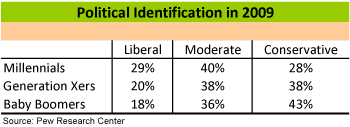Top Trends of the Millennial Generation
Move over Baby Boomers; the millennials are charging forward. These estimated 77.4 million millennials will be the driving force behind future market changes for many years to come and will comprise over 25 percent of the U.S. population. Despite discrepancies in timeframes, most consider any individual born between 1980 and 2001 a millennial. The millennials are primarily the children of the 76 million Baby Boomers born between 1946 and 1964 and the millennial generation will continue to surpass the boomers in size in the coming years. Below are some trends for millennials derived from recent surveys conducted by the Urban Land Institute and the Pew Research Center.
Educational Attainment
Higher education is a top priority among millennials. With increasing competition for jobs, more millennials are choosing to obtain higher education after high school. The Pew Research Center conducted extensive research through the use of surveys to understand the preferences and choices of the millennials in comparison to past generations. The group surveyed 2,020 individuals of which 830 are considered millennials. The survey results indicated that more than half (54%) of millennials have at least some college education compared to 49 percent of Generation Xers and 36 percent of Baby Boomers. These results suggest that millennials are more highly educated than past generations. Furthermore, survey results revealed that 60 percent of females have at least some college education whereas only 49 percent of males do. Thus, among millennials, females are more likely to have higher education than their male counterparts.
Housing Demand
Urban Land Institute conducted a survey of 1,241 individuals to understand the housing preferences of millennials. One of the most important findings of the survey revealed that millennials as a collective group prefer to live in central cities and suburban areas opposed to rural areas. The findings of ULI are supported by the findings of the Pew Research Center Polls which state that only 14 percent of millennials currently reside in rural areas opposed to 29 percent of Baby Boomers at comparable ages. In contrast, 54 percent of millennials live in suburbs now whereas only 41 percent of Baby Boomers lived in the suburbs in 1978.
Residing in a specific type of area is not the only housing trend among millennials. The millennials that were surveyed by ULI were between the ages of 18 and 32. Among those surveyed, two-thirds stated that they expected to own a home within the next five years while 90 percent of all surveyed plan to own a home at some point. Furthermore, the number of millennials turning 22 years of age is approximately 4 million per year until 2022, so increased demand for all forms of housing is expected in the coming years.
Marital Status
Although society has dubbed marriage as a vital part of life, millennials do not seem to think so. Millennials are far less likely to be married or have children than are past generations. Pew Research Center compared the marital status of individuals 18 – 28, of the millennial generation to other generations. Of the millennials between the ages of 18 and 28, only 21 percent are married whereas 29 percent of Generation Xers and 42 percent of Baby Boomers were married when they were between the ages of 18 and 28. Marriage therefore is not currently a priority for millennial’s and suggests that they may prefer to tie the knot at a later age.
Political Preference
 One of the most essential ways in which the millennials differ from past generations is their political views. In 2009, more millennials than Generation Xers and Baby Boomers indentified themselves as liberal while more Baby Boomers and Generations Xers than millennials classified themselves as conservative.
One of the most essential ways in which the millennials differ from past generations is their political views. In 2009, more millennials than Generation Xers and Baby Boomers indentified themselves as liberal while more Baby Boomers and Generations Xers than millennials classified themselves as conservative.
However, Pew Research Center data revealed that no matter what generation, the number of individuals in a specific generation that identify themselves as conservative increases as they get older. For example, in 1997, 35 percent Generation Xers and 40 percent of Baby Boomers identified themselves as conservative; compared to 38 percent Generation Xers and 43 percent Baby Boomers in 2009. The trend of becoming more conservative with age is likely to continue as the millennial’s age.